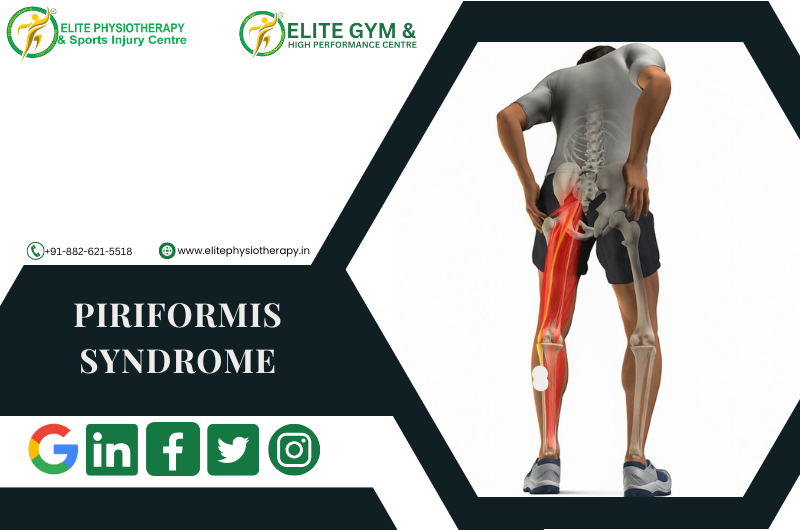What is Piriformis Syndrome?
Behind the gluteus maximus, deep in the buttocks, is a tiny, flat muscle called the piriformis. It joins the apex of the femur to the sacrum. Its main function is to support the pelvis and aid in hip rotation when walking or running. The sciatic nerve that passes through or beneath the piriformis muscle may be compressed if it gets tense, swollen, or spasms. The result of this is Piriformis Syndrome.
Causes of Piriformis Syndrome
- Overuse of muscles from repetitive sports like cycling or jogging
- Damage or trauma to the gluteal area
- Extended periods of sitting, particularly with bad posture
- Variations in anatomy, where the piriformis is where the sciatic nerve travels
- Piriformis muscle inflammation or spasm
- Conditions affecting the lumbar spine that lead to transferred sciatic pain
Classification of Piriformis Syndrome
Although there is no strict classification system, it is commonly categorized based on the cause:
- Primary Piriformis Syndrome: brought on by congenital defects or anatomical variances.
- Secondary Piriformis Syndrome: Caused by inflammation, misuse of the muscles, or trauma.
Clinical Features / Signs & Symptoms
- An excruciating, deep buttock pain
- Often misdiagnosed as sciatica, pain radiating down the back of the thigh
- Along the sciatic nerve distribution, numbness and tingling
- Increased discomfort when sitting or moving the hips
- The piriformis muscle is painful.
- Having trouble walking or climbing stairs, for example
Diagnostic Methods, Tests, and Physical Examination
Physical Examination and Special Tests
- Palpation: Potential involvement is indicated by tenderness over the piriformis muscle.
- Piriformis Muscle Stretch Test: The patient is in a supine position while the examiner passively rotates, adducts, and flexes the hip. Piriformis involvement is suggested by pain reproduction.
- Freiberg Test: Pain occurs when the extended thigh is forced to rotate internally.
- Pace Test: Pain in the piriformis region is caused by outward rotation of the hip and resisted abduction.
- Straight Leg Raise Test: It may be positive in certain situations; however, it aids in ruling out lumbar disc herniation.
- Imaging and Other Investigations: MRI or Ultrasound Imaging
Physiotherapy Management at Elite Physiotherapy and Sports Injury Centre
1. Manual Therapy and Soft Tissue Techniques
- Piriformis Muscle Release: Expert soft tissue release eases sciatic nerve constriction and eases tense muscles.
- Trigger point therapy: It reduces pain and spasms by applying direct pressure to muscular knots.
2. Therapeutic Exercises
- Stretching exercises that target the hamstrings, hip adductors, and piriformis to release tension.
- Strengthening exercises: To increase pelvic stability, strengthen your gluteus medius and core muscles.
- Exercises for Postural Correction: Focusing on spinal alignment and good sitting posture.
3. High-End Physiotherapy Modalities
- At Elite Physiotherapy and Sports Injury Centre, we employ advanced modalities for effective treatment:
- Shock Wave Therapy (SWT): High-energy waves stimulate tissue repair, reduce inflammation, and improve circulation.
- Super Inductive System (SIS): Provides deep heating, enhancing muscle relaxation and reducing spasms.
- High Intensity Laser Therapy (HILT): Accelerates tissue healing and reduces nerve-related pain by penetrating deep tissues.
- Dry Needling: Thin needles target trigger points to release muscle tension and improve blood flow.
- Cupping Therapy: Increases circulation and releases fascial restrictions in the piriformis and surrounding tissues.
4. Education and Lifestyle Modification
- Educating patients on avoiding prolonged sitting, proper stretching, and regular exercise prevents recurrence.
5. Home Exercise Program
- We provide personalized home exercise programs, including stretching and strengthening exercises, to maintain progress.
Why Choose Elite Physiotherapy and Sports Injury Centre?
At Elite Physiotherapy and Sports Injury Centre, we provide highly individualized physiotherapy service together with cutting-edge diagnostic methods. Utilizing cutting-edge technologies and evidence-based techniques, our skilled team specializes in treating Piriformis Syndrome. We guarantee that each patient gets a comprehensive evaluation and a customized treatment strategy.
Combining manual therapy, therapeutic exercises, and state-of-the-art techniques like Shock Wave, SIS, HILT, Dry Needling, and Cupping improves our outcomes. We provide patients with the information and resources they need for long-term recovery in addition to treatment.

